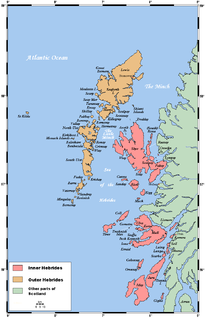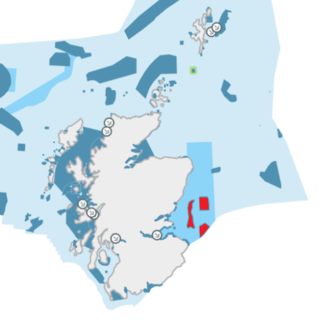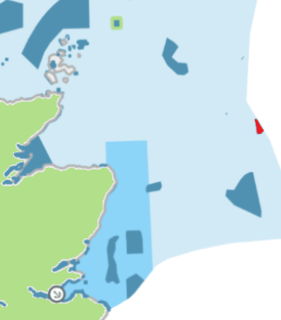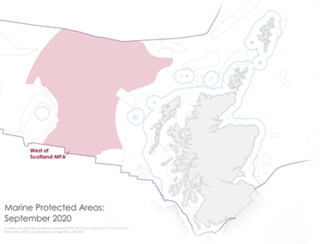
The Rockall Trough is a deep-water bathymetric feature to the northwest of Scotland and Ireland, running roughly from southwest to northeast, flanked on the north by the Rockall Plateau and to the south by the Porcupine Seabight. At the northern end, the channel is bounded by the Wyville-Thomson Ridge, named after Charles Wyville Thomson, professor of zoology at the University of Edinburgh and driving force behind the Challenger Expedition. At the southern end, the trough opens into the Porcupine abyssal plain. The Rockall Basin is a large sedimentary basin that lies beneath the trough. Both are named after Rockall, a rocky islet lying 301.4 km west of St Kilda.

The Sea of the Hebrides is a small, partly sheltered section of the North Atlantic Ocean, indirectly off the southern part of the north-west coast of Scotland. To the east are the mainland of Scotland and the northern Inner Hebrides ; to the west are the southern Outer Hebrides islands, principally South Uist, Eriskay, and Barra. To the north is the Little Minch, a channel connecting it with the Minch.

Bowie Seamount is a large submarine volcano in the northeastern Pacific Ocean, located 180 km (110 mi) west of Haida Gwaii, British Columbia, Canada.

The Anton Dohrn Seamount is a guyot in the Rockall Trough in the northeast Atlantic. It is 1.8 kilometres (1.1 mi) high and is topped with pinnacles, one of which reaches a depth of 530 metres (1,740 ft). Away from the flat top upon which the pinnacles rest, the slopes fall off steeply into the Rockall Trough and a moat in the sediment that surrounds the seamount.
The following outline is provided as an overview of and introduction to Oceanography.

The habitat of deep-water corals, also known as cold-water corals, extends to deeper, darker parts of the oceans than tropical corals, ranging from near the surface to the abyss, beyond 2,000 metres (6,600 ft) where water temperatures may be as cold as 4 °C (39 °F). Deep-water corals belong to the Phylum Cnidaria and are most often stony corals, but also include black and thorny corals and soft corals including the Gorgonians. Like tropical corals, they provide habitat to other species, but deep-water corals do not require zooxanthellae to survive.

Loch Creran is a sea loch in Argyll, on the west coast of Scotland. It is about 10 kilometres (6.2 mi) long from its head at Invercreran to its mouth on the Lynn of Lorne, part of Loch Linnhe. The loch separates the areas of Benderloch to the south and Appin to the north. The island of Eriska lies at the mouth of the loch. The loch is bridged at its narrowest point at Creagan, by the A828 road. The village of Barcaldine lies on the south shore of the loch.
Rosemary Bank is a seamount approximately 120 kilometres (75 mi) west of Scotland, located in the Rockall Trough, in the northeast Atlantic. It was discovered in 1930 by the survey vessel HMS Rosemary, from which it takes its name. It is one of only three seamounts known in Scottish waters.

Hotspot Ecosystem Research and Man's Impact On European Seas (HERMIONE) is an international multidisciplinary project, started in April 2009, that studies deep-sea ecosystems. HERMIONE scientists study the distribution of hotspot ecosystems, how they function and how they interconnect, partially in the context of how these ecosystems are being affected by climate change and impacted by humans through overfishing, resource extraction, seabed installations and pollution. Major aims of the project are to understand how humans are affecting the deep-sea environment and to provide policy makers with accurate scientific information, enabling effective management strategies to protect deep sea ecosystems. The HERMIONE project is funded by the European Commission's Seventh Framework Programme, and is the successor to the HERMES project, which concluded in March 2009.

The Community of Arran Seabed Trust (COAST) is a registered Scottish charity based on the Isle of Arran, the largest island in the Firth of Clyde. Established in 1995 by two local divers COAST has been a registered charity since 2011 and is run mostly by Arran residents, who all share the same aims to protect the health of the marine environment around the Isle of Arran and within the Firth of Clyde from indiscriminate commercial fishing methods. COAST values the marine biodiversity around the shoreline of Arran and aims to regenerate and protect it for future generations.
The marine protected areas of South Africa are in an area of coastline or ocean within the exclusive economic zone (EEZ) of the Republic of South Africa that is protected in terms of specific legislation for the benefit of the environment and the people who live in and use it. An MPA is a place where marine life can thrive under less pressure than unprotected areas. They are like underwater parks, and this healthy environment can benefit neighbouring areas.
The Southwest Indian Seamounts Marine Protected Area is an offshore conservation region in the exclusive economic zone of South Africa

In Scotland, Marine Protected Areas (MPAs) are areas of sea defined so as to protect to habitats, wildlife, geology, undersea landforms, historic shipwrecks, and to demonstrate sustainable management of the sea. As of December 2020, approximately 37% of Scotland's seas are covered by the Scottish MPA network, which comprises 244 sites in total.

The Faroe–Shetland Channel is stretch of the North Atlantic lying between the two island groups of Shetland and the Faroe Islands. The channel is a rift basin that separates the Scottish and the Faroese continental shelves, and has a maximum depth of 1900 m, compared to the surrounding seabed which mostly lies at 200 m. It was first noted by Charles Wyville Thomson during the mid-nineteenth century.

The name Firth of Forth Banks Complex refers to a complex of sand and gravel sea banks in the North Sea, lying at the mouth of the Firth of Forth in the seas off the east coast of Scotland. From south to north the banks are named the Berwick Bank, the Scalp Bank, the Wee Bankie and the Montrose Bank. Since 2014 the banks have been protected as a single Nature Conservation Marine Protected Area, which comprises three discrete zones covering a total area of 213,000 hectares (2,130 km2) of Scottish Offshore Waters.

The Geikie Slide is a submarine landslide on the seabed of the North Atlantic Ocean to the northwest of Scotland. The slide occurs in a region known as the Hebridean Slope, the continental slope where the seabed drops from the continental shelf surrounding Britain into the deep ocean. Since 2014 an area of 2,215 square kilometres (855 sq mi) has been designated as a Nature Conservation Marine Protected Area under the name Geikie Slide and Hebridean Slope MPA.

The Norwegian Boundary Sediment Plain is a Marine Protected Area (MPA) lying to the northeast of Scotland. The MPA, which covers 164 km2 (63 sq mi), lies at the very edge of Scottish offshore waters, close to the maritime boundary with Norway. The seabed of the sediment plain consists of sand and gravel habitats, and lies at a depth of between 80 and 120 metres below sea level. The sea bed supports creatures such as starfish, crabs and ocean quahogs. The latter, which are large and slow growing clams, have a lifespan of more than 400 years and are thus considered to be amongst the oldest living animals on Earth.
Hebrides Terrace Seamount is a seamount in the Atlantic Ocean, west-southwest from the Hebrides, Scotland. It formed through volcanism during the early Cenozoic in the Rockall Trough 60 million to 67 million years ago and afterwards sank below sea level. Presently, it is a flat-topped underwater mountain that rises to about 980 metres depth. "Coral gardens" that host a number of animals are found on its slopes.

The Turbot Bank is a shelf bank and mound feature of the seabed of the North Sea that lies off the east coast of Scotland, about 44 kilometres (27 mi) east of Peterhead. The depth of water above the bank varies from 60 m below sea level on top of the bank down to 80 m at its margins. It has been designated as a Nature Conservation Marine Protected Area since 2014.

The West of Scotland Marine Protected Area covers a large area of the North Atlantic to the west of the Outer Hebrides. The Marine Protected Area (MPA) was designated by the Scottish Government in 2020, replacing the Rosemary Bank MPA, which covered a much smaller area. Covering a sea area of over 100,000 square kilometres (39,000 sq mi), it is the largest marine protected area in Europe.














